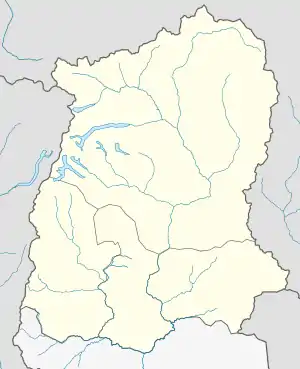Kyongnosla Alpine Sanctuary
Kyongnosla Alpine Sanctuary is a wildlife sanctuary in East Sikkim, India. It is situated around the area adjoining the Tsomgo (Changu) lake along the Nathula Road. Located about 31 km (19 mi) east of Gangtok, the capital of Sikkim, this sanctuary covers an area of about 31 km2 (12 sq mi), and extends from the "15th Mile" police check point up to and along the ridges bordering the Rong Chu Valley and Lake Tsomgo.
| Kyongnosla Alpine Sanctuary | |
|---|---|
 Location within Sikkim | |
| Location | East Sikkim, India |
| Nearest city | Gangtok |
| Coordinates | 27°22′37″N 88°44′28″E[1] |
| Area | 31 km2 (12 sq mi) |
| Established | 1977 |
Rich in both flora and fauna, rare, endangered ground orchids and rhododendrons interspersed among tall junipers and taller silver firs are among the important plants present.[2] Rhododendron niveum (the State Tree of Sikkim) and Cypripedium tibeticum (the ground slipper orchid), which is on the verge of extinction, have also been introduced here.
Kyongnosla Alpine Sanctuary is part of the Sacred Himalayan Landscape.[3][4]
References
- Sikkim Forest Department: Wildlife
- O'Neill, A. R. (2019). "Evaluating high-altitude Ramsar wetlands in the Sikkim Eastern Himalayas". Global Ecology and Conservation. 20 (e00715): 19. doi:10.1016/j.gecco.2019.e00715.
- Gurung, C. P.; Maskey, T. M.; Poudel, N.; Lama, Y.; Wagley, M. P.; Manandhar, A.; Khaling, S.; Thapa, G.; Thapa, S.; Wikramanayake, E. D. (2006). "The Sacred Himalayan Landscape: Conceptualizing, Visioning, and Planning for Conservation of Biodiversity, Culture and Livelihoods in the Eastern Himalaya" (PDF). In McNeely, J. A.; McCarthy, T. M.; Smith, A.; Whittaker, O. L.; Wikramanayake, E. D. (eds.). Conservation Biology in Asia. Kathmandu: Nepal Society for Conservation Biology, Asia Section and Resources Himalaya Foundation. pp. 10–20. ISBN 99946-996-9-5.
- O'Neill, A. R.; Badola, H.K.; Dhyani, P. P.; Rana, S. K. (2017). "Integrating ethnobiological knowledge into biodiversity conservation in the Eastern Himalayas". Journal of Ethnobiology and Ethnomedicine. 13 (1): 21. doi:10.1186/s13002-017-0148-9. PMC 5372287. PMID 28356115.
- Envis Team (4 June 2006). "Ecodestination of India-Sikkim Chapter" (PDF). Eco-destinations of India. Envis Centre Sikkim. Archived from the original (PDF) on 19 June 2007. Retrieved 1 December 2006.